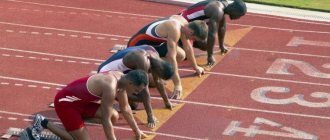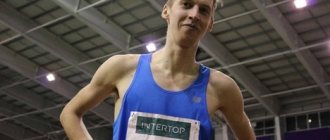Running 100m is not a time when you have to save energy or calculate your average speed. Short distance race consists of four stages:
- start
- starting run
- direct distance
- finishing
And to win the 100-meter race, you need to take into account the features of each stage. The tactics and speed of movement in these areas will be different. The rapid takeoff from the start turns into powerful acceleration, and over the next moments the runner reaches maximum speed. His main task is to save it to the finish line and be the first to touch the coveted ribbon.
Further:
Start. Low start from the pads
Before learning to start from the blocks, you need to master starting from a falling position. Stand up straight, hands at your sides, and begin to lean forward. Take your first step just before you fall. The leg you take a step with will be the swing leg. At the moment of starting from the blocks, it will be at the back.
The next step is to start from a fall position from a low start. Lean forward, bending in half. The swing leg is slightly behind the pushing leg. Lower your arms down, but don't touch the track. Lean until you start to fall, and only then start moving forward.
Now you can start training to start from the blocks.
Installation of pads
We install the base of the pads, retreating from the starting line by the length of one foot. Make sure that it is exactly in the middle of the running strip. Step on the base to improve its grip on the surface.
We install the first block at a distance of two feet from the starting line. The second one is one foot from the first block or three from the starting line.
The angle of the pads is set individually. Typically, for the push leg, which is closer to the starting line, the block is set to the bottom or second to last position. The block for the swing leg is installed in a higher position.
You need to approach the pads from the front, not from the top. Stand in front of them, place your hands on the floor, then put your feet on the block and lower your knees.
Starting from the blocks
At the command “Start!” take the correct position on the blocks. The weight is evenly distributed between the five supports: arms, feet and knee of the swing leg. The hands should be straight in front of the starting line, resting on the surface with the thumbs and forefingers.
At the command “Attention!” Press your soles firmly into the pads and lift your pelvis. Keep your body straight. The head should be tilted down and the gaze directed towards the track. The center of gravity is transferred to the hands and feet.
At the start signal, begin an instant, explosive movement. Push off strongly from the surface, make a quick swing with bent arms. Straighten your front leg sharply and at the same time take a wide step with your back leg.
Starting run
A good start gives you the advantage of a fast starting run. The take-off run is the first third of the distance, which is covered at 90-95% of the maximum speed. The higher the runner's qualifications, the larger part of the distance is the run-up.
After the start, the body is in a forced bent state. Remember that the first steps of acceleration should be frequent, and the stride length should be optimal to maintain the selected body inclination. Don't try to stand up completely straight during the first moment of running. If you immediately straighten up and look forward, you will lose time and conditions for an effective run. Straighten your body gradually, over the first 7-10 steps of the movement.
How to run the distance
At the third stage of the distance - approximately 20-30 meters after the run - you need to move at maximum speed. The arms are bent at the elbows and move intensively along the body. Do not lift them high, try to work with your hands in the direction of movement. Your running technique should be familiar. Don't try to artificially increase your stride length by throwing your leg forward. Your powerful movement should come from your hamstrings and glutes.
Pay attention to some points that will help you run at maximum speed:
- The feet should be on the same line, this promotes better coordination of movement.
- Try to place your feet with your toes forward for better push-off.
- When both legs are in flight, the hip of the swing leg should be perpendicular to the track. This movement develops speed due to inertia.
- When your foot touches the track, your knees should be together, or the knee of your swing leg should be slightly ahead of your supporting leg. This will help reduce stance time and increase speed.
- in the full support position, when the foot is directly under the body, the leg is slightly bent. The correct position of both legs is the conventional number “4”.
- At the moment of takeoff, the body is in a natural position, the pushing leg is slightly bent at the knee. The vertical nature of repulsion provides a high flight trajectory and increased speed.
Running technique
Regardless of what distance you plan to run quickly, at the initial stage one of the fundamental determinations for you should be running technique. It will significantly improve your running speed.
For a sprinter, technique is the key to a high result; for an average athlete, it is a means of increasing one’s efficiency over a distance to 100%; for a stayer, it is running economy.
The SBU complex (special running exercises) is aimed at learning to run correctly, beautifully and efficiently. They need to be performed at every workout, working on your running technique. Ideally, the body should maintain a straight line with the feet, hips and head on the same inclined line.
Hand position
Many people think that running is an activity exclusively for the legs, and that hands are needed to hold the phone, bottle, keys, etc. This is a big mistake: when running, it is equally important to use core strength and arm movement.
Correct arm movements make the work of your legs much easier and allow you to run longer distances with less effort. The hands should be relaxed, the shoulders slightly raised, the elbows bent, and the movements should be along the body, not in front of it.
Read on the topic: Hand technique when running
Step length
Do not try to take large steps; the size of your running step depends on the degree of your physical activity and the duration of your training. Moreover, a step that is too wide will cause the foot to get ahead of the center of gravity and slow down the movement. When you stand on the ground, your foot should be exactly under your knee.
Pay attention to the level position of your back, try not to sway from side to side. One of the most common mistakes among untrained runners is that they look deep down, straining the cervical spine.
Breath
Breathing while running at higher speeds takes practice. Breathe through both your nose and mouth to get the maximum amount of oxygen delivered to your muscles.
Long Distance Running Technique: 5 Basic Rules
Finish throw
During the last stage of the race, the sprinter's speed usually drops by 3-8%. But the close finish is not a reason to pause deliberately. Instead, brace yourself for the final throw. The athlete with the highest running endurance wins the competition.
The end of the course is usually indicated by a ribbon that runs along the finish line. There are two ways to finish : when the sprinter touches the ribbon with his chest or shoulder. Both methods provide approximately equal opportunities to be the first to reach the finish line. The choice depends on the athlete's preferences.
The so-called “ chest throw ” is performed as follows: at the last stage of the race, sharply lean your chest forward, throwing your arms back.
To touch the finishing tape with your shoulder , you also need to lean forward while turning your shoulder towards the tape.
With both methods, the movement technique is the same: the runner shifts the center of gravity forward, while the upper body accelerates and the lower part slows down slightly. After contact with the finishing tape, you must sharply throw your swing leg forward. This will help avoid falling. “Stepping” on the leg shifts the center of gravity of the body back, the runner’s speed drops, and he gradually switches to walking.
Sprinters who have not mastered either of these methods are advised to run the finish line at maximum speed, without thinking about throwing themselves at the ribbon.
Athlete training for 100 meter distance
To run a hundred-meter distance, you need excellent coordination of movements (one hundred percent sense of your own body), speed qualities and endurance (the work is short, but at the maximum limits). A set of special exercises will help develop these qualities. During training, athletes perform exercises several times. The method predominantly used is to practice repeated running over certain parts of the distance, allowing you to work out your speed on each segment. A race of ten meters, then twenty, the distance constantly increasing. The speed in all areas is maximum. In the last sections (80-100) meters, the speed can be reduced by 95%. Athletes cover the distance several times.
Workouts for runners include a series of exercises with additional weights. The purpose of such exercises is to develop all muscle groups in the legs and increase their endurance. Speed and coordination are greatly improved when running in mountainous areas.
Running training for sprint distances
The most important quality for winning a sprint is the ability to maintain high speed until the end of the distance, that is, special sprint endurance. To develop specialized endurance, you need to include running short distances at maximum intensity into your training plan.
When running at a 100-meter distance, the body's energy supply occurs through the creatine phosphate and lactate systems. During the first 6-8 seconds of the race, maximum acceleration is provided by the creatine phosphate system. The lactate system allows you to maintain your speed until the finish line.
Starting Acceleration Training
The body must work with maximum load for 6-8 seconds. To do this, run segments of 30-60 meters at maximum speed. If you run 15 times 30 meters, take breaks of 6-7 minutes. This is an important condition for training the creatine phosphate system. Try running fast with an additional load (tire or parachute).
Endurance training at a distance
We take longer running segments, from 60 to 150 meters, but the rest between repetitions should be minimal.
For example:
- 10-15 times 60 meters at a speed slightly below maximum
- rest between repetitions 1-1.5 minutes
- walk or jog back.
You can also run 10 times 100 meters or 7 times 150 meters instead of 60-meter segments.
It is better to alternate such training: once a week you train the creatine phosphate system, once a week - the lactate system. Between intense workouts, run light cross-country to speed up recovery.
To understand exactly where the 100m running technique requires additional development, you can use the table for ideal distance covering .
| Speed, m/sec | 30 meters on the move | 30 meters, n/start | 60 meters, n/start | 100 meters, n/start | 200 meters, n/start |
| 12,0 | 2,5 | 3,5 | 6,4 | 9,9 | 20,2 |
| 11,5 | 2,6 | 3,6 | 6,5 | 10,1 | 20,6 |
| 11,1 | 2,7 | 3,7 | 6,6 | 10,3 | 21,0 |
| 10,7 | 2,8 | 3,8 | 6,8 | 10,6 | 21,6 |
| 10,3 | 2,9 | 3,9 | 6,9 | 10,8 | 22,0 |
| 10,0 | 3,0 | 4,0 | 7,0 | 11,0 | 22,4 |
For example, you run 30 meters from a low start in 3.6 seconds, and cover a distance of 60 meters in 6.8 seconds. At the same time, the total time for a distance of one hundred meters is 11.4 seconds. This means that it is necessary to train running endurance, since this particular section of the route is covered at the slowest speed.
This table is suitable for assessing your preparation and creating a training plan taking into account problem sections of the distance.
The development of special endurance in preparation for competitions is carried out with varying intensity. The heaviest load occurs as the competitive period approaches. During the competition, the intensity is maintained, and in the transition period it decreases.
How to prepare for a race from scratch
Since 1 km is a standard distance for educational institutions of different age categories, we decided to help beginners prepare for such races.
It doesn't matter whether you are a schoolboy, a student, or an adult. If you haven't run before, the following information is for you.
Let's start preparing for the 1000 meters from scratch
Make it a rule to jog 4-5 times a week. Run in the morning. The first stage is strengthening the body.
There is no need to immediately measure speed data. That is, it is wrong to immediately check the minimum time for which you will run 1000, 1500 meters, and so on.
Training should be gentle and start small.
It is best to run in the morning, when the streets are not clogged with vehicles and people. Leave the house and walk briskly for about 2-3 minutes. Stretch, wave your arms, twist your head, raise your legs high.
Next, we switch to jogging - slowly, without rushing. Run at this pace for as long as you decide. For the first week, jogs lasting 10–15 minutes are suitable.
Practice has shown that if you move to a walk because of fatigue, there will be no progress. Therefore, if you run out of energy and the required time has not yet elapsed, slow down as much as possible, but continue to imitate running movements.
For the second week, increase your running time by 2-3 minutes every day. When you reach 30-40 minutes, you are ready for further preparation.
2–3 weeks after starting training
Your body has already learned what running is. You began to notice that when climbing stairs, shortness of breath appears less frequently and disappears faster if it does appear.
It makes you happy and motivating! You feel more energetic and joyful. After all, running adds happiness to life, it’s been proven.
Now let's start practicing interval running. Every workout will now be a little different.
2-3 times a week we will try to run 100 meters with good acceleration, and then switch to running as slowly as possible to restore breathing. We ran 100 meters, then run for 1 minute and even out our breathing. You need to do this for a week.
In the second week we increase the intervals to 150 meters. On the third - up to 200 meters. Now we try to run as fast as possible.
Carefully monitor your body; if heart problems appear, limit yourself to regular jogging in the morning without acceleration, consult your doctor.
If you tingle in your side, everything is fine, your body is just not quite ready for the serious stress of sprinting.
After 6 weeks
You will be running 800 meters at a fast pace. You don’t need to drive too hard, this is not a sprint, but the speed should be clearly higher than your average. That's it, the comfort is over, the work for a while has begun. A day later, try to run 800 meters again, taking into account your own impressions from the last run.
If last time you were exhausted before you reached the finish line, start slower. If you have some strength left, maybe you should speed up a little?
Next week we move on to running 1000 meters (twice a week). We try to keep the same speed as at 800 meters.
And finally, for the next 2 weeks we practice 1500 meters (twice a week). Let us note once again that this is not a sprint; there is no need to issue maximum speeds here.
Training at 1500 meters will allow you to run the cherished 1000 more efficiently. Your body will get used to this distance, after which you will easily overtake all your competitors in your class or group, showing excellent results.
The workout should be complete - warm-up, running, cool-down. The program is simple - 5 minutes warm-up, 1500 meters for time and 10-15 minutes to restore breathing and cool down. We train endurance. On other days we practice regular easy running without acceleration.
What to do next
If you're interested, you can run the 3000 meters as a mini-exam. This is the standard for physical culture in universities of the Russian Federation.
In fact, you are already ready to run a kilometer, and you can easily run 3 km. By this time, your running technique has already been honed, you feel when you need to speed up and when to slow down a little, you know your capabilities. This is the main thing. For an amateur, you are already pretty good at running.
Therefore, you can start practicing middle distance running. For example, jog 5–7 km every other day. On the remaining 2 days, limit yourself to 3 km (we agreed that jogging would take place 5 times a week).
Once you pass the 1000 meter standard, continue running for fun. The program will no longer include interval elements.
Physical preparation for sprint distances
In addition to general physical training, in the preparatory period the volume of special running exercises (SBU) increases. SBU are aimed at training speed, strength and flexibility, as well as strength and running endurance.
SBUs are designed to selectively target specific muscle groups. These exercises also develop proper technique and skills that will help you run the 100m correctly.
The most effective running exercises:
Multi-jump, or “deer run”
This is running with wide steps, with a powerful push-off with the supporting leg, which ensures a slight hover (flight phase) of the body above the surface. You can alternate multi-jumps on one and two legs. Pay attention to the correct execution of this exercise:
- Land on your toes, not your entire foot.
- don't clench your hands into fists
- look forward
- fully straighten your pushing leg
Jumping exercises
Jumping from foot to foot
The movement occurs due to jumping. At the same time, the pushing leg straightens completely, and the thigh of the swing leg rises high.
Triple jump
Stand up straight, raise your arms up. Squat down and, helping yourself with your hands, push your body forward, as if jumping from a standing position. But you land on one leg and immediately take a wide jump with your other leg. Your third jump is to land on both feet. You can do the first two jumps with your right foot and land on both, and then repeat the exercise with your left foot.
Jumping off the blocks with two legs
This exercise promotes a quick and explosive start. Place the pads at the same level, and place a sports mat at a distance of 1.5 meters. Take a crouched position, then raise your pelvis, as at the start, and make a sharp jump.
Running with high knees
Your task is to keep your body slightly leaned forward and raise your knees to the level of your pelvis or higher. In this case, the heels should be under the knee, and not under the buttock, that is, the foot is parallel to the running surface.
Running with overwhelm
In this exercise, it is important to observe one condition: the heel rises to the buttock, but at the same time the toe points to the floor, and the knee automatically moves forward. There is no need to bend your knee too much and throw your heel back.
Running on straight legs
With this running technique, the legs are thrown forward at an angle of 45 degrees and are bent very slightly. The body is also slightly tilted forward, the abs are tense. Your task is to develop the maximum possible speed by quickly mixing and changing legs.
Mincing run
The movement occurs through short steps, landing on the forefoot. The body and arms are relaxed, the running speed is low.
"Bike"
The movement of the legs is reminiscent of pedaling when riding a bicycle. The thigh of the swing leg is raised high, and the lower leg is thrown forward. You need to land on the front of your foot, while making a quick “raking” motion with your foot down and back, as if you were trying to hold the pedal.
Lunges
The front leg is bent at the knee at a right angle, the toe of the back leg rests on the ground, the knee does not touch the surface. Push off and take a long step with your back leg, returning to your original position.
Remember that all exercises are done only after a preliminary warm-up.
Preparing for a 10 km race: training plan and coach tips
It often happens that we go to the gym, train and promise ourselves that we will finally go for a run. Today is the day - put on your sneakers, set a goal - to run 10 km, and with a good result - and train with the “Championship”, because you are already ready to run, you just need to start!
Photo: istockphoto.com
Universal rules for preparing for a race
- Before jogging, warm up for 15 minutes, cool down for 10 minutes after.
- 3-4 workouts per week.
- We combine and alternate the load: interval training to develop speed, tempo running, long jogging, training in the gym or on the street for all muscle groups.
- You can start a long run slowly, which will already be a warm-up, but you need to finish it faster than the pace set by the plan.
- We increase the weekly volume gradually, no more than 10% of the total load.
- You can calculate your pace using an online running pace calculator, but be guided primarily by how you feel.
- Don't forget about rest and recovery time. The training plan can and should be adjusted to suit your schedule and health status.
Photo: istockphoto.com
Training plan
The optimal period of preparation for a 10 km race is 12 weeks, the minimum is 6 weeks. The program is also designed for beginners. So stop putting off the ephemeral later, if you have minimal physical fitness, go for a run, follow the plan and don’t forget to register for the race.
| Mon | W | Wed | Thu | Fri | Sat | Sun |
| 1st week | Tempo workout: easy run 1 km 3 km at 10 km pace easy run 1 km | Interval training: 8 times 400 m, rest between intervals - 30 seconds | Training | Long run – 6 km at 21 km pace | ||
| 2nd week | Tempo workout: 1.5 km at 10 km pace Easy run 1.5 km 3 km at 10 km pace | Interval training: 5 times 800 m, rest – 30 seconds | Training | Long run – 8 km at an easy comfortable pace | ||
| 3rd week | Tempo workout: easy run 1.5 km 3 km at 5 km pace Easy run 1.5 km | Interval training: 2 times 1600 m, 1 time 800 m, rest – 400 m jogging | Long run – 8 km at 21 km pace | |||
| 4th week | Tempo workout: 3km at 5km pace easy run 1.5km 1.5km at 5km pace Easy run 1.5km 1.5km at 5km pace | Interval training: “staircase back and forth” 400 m – 600 m – 800 m – 800 m – 600 m – 400 m, rest – 400 m jogging | Training | Long run – 10 km at an easy comfortable pace | ||
| 5th week | Tempo workout: 6.5 km at 10 km pace | Interval training: 4 times 1000 m, rest - 30 seconds | Training | Long run – 12 km at 21 km pace + 15 sec | ||
| 6th week | Tempo workout: easy run 1.5 km 5 km at 10 km pace Easy run 1.5 km | Interval training: “staircase down” 1600 m – 1200 m – 800 m – 400 m, rest – 400 m jogging | Training | Long run – 14 km at 21 km pace | ||
| 7th week | Tempo workout: 1.5km easy run 6.5km 10km pace Easy 1.5km run | Interval training: 10 times 400 m, rest – 200 m jogging | Training | Long run – 10 km at 10 km pace + 20 sec | ||
| 8th week | Tempo workout: easy run 1.5 km 3 km at 10 km pace Easy run 1.5 km 3 km at 5 km pace Easy run 1.5 km | Interval training: 6 times 800 m, rest – 90 seconds | Training | Long run – 15 km at 21 km pace | ||
| 9th week | Tempo workout: Easy run 2 km 5 km at 5 km pace Easy run 1.5 km | Interval training: 4 times 1200 m, rest – 400 m jogging | Training | Long run – 12 km at 10 km pace + 20 sec | ||
| Week 10 | Tempo workout: easy run 1.5 km 8 km at 10 km pace | Interval training: 5 times 1000 m, rest – 400 m jogging | Training | Long run – 14 km at 10 km pace + 15 sec | ||
| Week 11 | Tempo workout: easy run 1.5 km 6 km at 5 km pace Easy run 1.5 km | Interval training: 3 times 1600 m, rest – 400 m jogging | Training | Long run – 12 km at 21 km pace | ||
| Week 12 | Interval training: 6 times 400 m, rest – 60 seconds | Training | Easy 5K Run | Start! |
100 meter run standards (in seconds)
The world record of Usain Bolt , who ran 100 meters in 9.58 seconds in 2009, has not yet been broken by anyone. The 100-meter running standards are more flexible, but to achieve such results you will have to work hard.
| Men | Women | |
| Master of Sports (MS) | 10,4 | 11,6 |
| Candidate Master of Sports (CMS) | 10,7 | 12,2 |
| I category | 11,1 | 12,8 |
| II category | 11,7 | 13,6 |
| III category | 12,4 | 14,7 |
| I youth category | 12,8 | 15,3 |
| II youth category | 13,4 | 16,0 |
| III youth category | 14,0 | 17,0 |
60 meter run: standards
If you are confident in your physical fitness, you can try your hand at competitions and get a rank in running. To do this, you need to know the standards that are given in the table. Time is given in seconds.
| 1st category | 2nd category | 3rd category | Candidate Master of Sports | |
| Boys | 8.2 s | 8,7 | 9,3 | |
| Girls | 9,4 | 9,9 | 10,5 | |
| Men | 7,1 | 7,4 | 7,8 | 6,8 |
| Women | 8 s | 8,4 | 8,9 | 7,6 |











